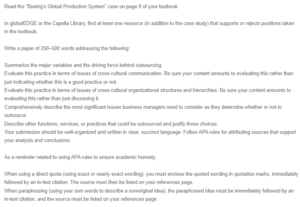Variables in Global Markets
The decision to outsource some of the business’s productions or services is not an easy one to make, yet necessary. There are several factors that need to be considered by a business before making the decision. Boeing is an example of a company that has benefited and experienced some issues with outsourcing the production of raw materials for its planes. The following is a discussion of some of the issues of consideration when outsourcing.
Major Variables and Driving Forces Behind Outsourcing
One of the variables of consideration when making the decision to outsource is quality. A business can choose to get some products/services overseas because the countries have better technology and resources to get the needed quality. For instance, Boeing got its wings made by Toray Industries in Japan because the company has better expertise in producing carbon fiber composites (Hill & Hult, 2017). Another factor to consider is the cost benefits of outsourcing to a business. Sometimes, manufacturing overseas can be significantly cheaper than manufacturing locally. Boeing got into agreements with the countries from where its manufacturing occurs to bring them business in exchange for the countries’ purchases of the company’s products.
Cross-Cultural Communication in Outsourcing
When doing business in an international market, business managers encounter many challenges. One of the major challenges encountered is cross-cultural communication issues. Differences in languages and non-verbal communication cues influence the ability to do business internationally (Steger, 2017). For instance, Boeing needs to have a way to connect to people in the Japanese market, where some of its parts are manufactured. Without effective communication, it is hard for the company to get into reasonable agreements that benefit both parties.
Cross-Cultural Organizational Structures and Hierarchies
Another factor that might affect a business in its efforts to outsource is cross-cultural organizational structures and hierarchies. Every country has a different culture shared by a majority of its residents. This makes the appropriate way to manage an organization to be varied in different countries. For example, people from an individualistic culture may prefer a rigid organizational structure that does not encourage team communication and collaboration. On the other hand, collective cultures may prefer a structure that promotes collaboration. Therefore, managers need to be careful to ensure that the organizational structure is best suited for the diverse teams they encounter when outsourcing.
Issues to Consider in Outsourcing Decision-making
When trying to decide whether to outsource or not, there are some factors that managers must consider. First, the business must determine the costs of outsourcing vs producing within the business. The goal is saving costs most of the time; thus, a business must choose the option that is most favorable (McIvor, 2008). Managers must also consider quality. If only an external company has the facilities to produce the level of quality that is needed, then outsourcing is recommended. The trustworthiness of the company to do the production must also be considered (McIvor, 2008). A business must choose a producer that is consistent with the production of good quality.
Functions, Services, or Practices that could be outsourced
There are many services, functions, and practices that a business can outsource aside from production, as in Boeing’s case. For instance, a business can choose to outsource a service/function such as marketing or IT operations. This eases the organization’s burden on performing these functions.
References
Hill, C., & Hult, T., (2017). Global Business Today Asia-Pacific Perspective. McGraw-Hill Education.
McIvor, R. (2008). What is the right outsourcing strategy for your process? European Management Journal, 26(1), 24-34.
Steger, M. B. (2017). Globalization: A very short introduction (Vol. 86). Oxford University Press.
ORDER A PLAGIARISM-FREE PAPER HERE
We’ll write everything from scratch
Question

Variables in Global Markets
Read the “Boeing’s Global Production System” case on page 9 of your textbook.
In globalEDGE or the Capella Library, find at least one resource (in addition to the case study) that supports or rejects positions taken in the textbook.
Write a paper of 250–500 words addressing the following:
Summarize the major variables and the driving force behind outsourcing.
Evaluate this practice in terms of issues of cross-cultural communication. Be sure your content amounts to evaluating this rather than just indicating whether this is a good practice or not.
Evaluate this practice in terms of issues of cross-cultural organizational structures and hierarchies. Be sure your content amounts to evaluating this rather than just discussing it.
Comprehensively describe the most significant issues business managers need to consider as they determine whether or not to outsource.
Describe other functions, services, or practices that could be outsourced and justify those choices.
Your submission should be well-organized and written in clear, succinct language. Follow APA rules for attributing sources that support your analysis and conclusions.
As a reminder related to using APA rules to ensure academic honesty:
When using a direct quote (using exact or nearly exact wording), you must enclose the quoted wording in quotation marks, immediately followed by an in-text citation. The source must then be listed on your references page.
When paraphrasing (using your own words to describe a nonoriginal idea), the paraphrased idea must be immediately followed by an in-text citation, and the source must be listed on your references page.

